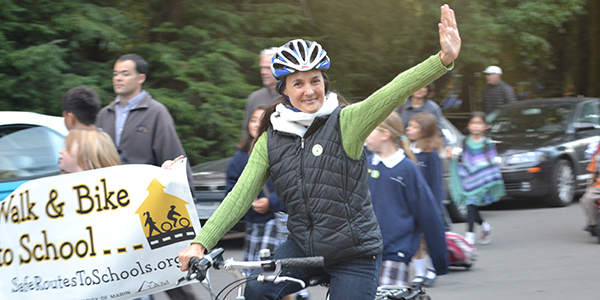 The National Conference is off to a strong start here in Columbus, Ohio.
The National Conference is off to a strong start here in Columbus, Ohio.
Resource Library
Look both ways. Wear your helmet. We’ve all heard these maxims about safety, and probably shared them a time or two.
Aside from distance to school, safety is a leading factor for both adults and children in the decision to participate in physical activity and walk or bike to school (Nasar, 2015; Zhou et al., 2009). However, adopting those individual protective behaviors will not provide an easy solution. This blog post will unpack three reasons why the concept of safety, particularly in the context of safe travel to school, can be challenging to conceptualize and achieve.

People often ask me how I became the director of the Safe Routes Partnership and where the movement is headed now that the program is under attack by some members of Congress.
 Recently, as I returned home after discussions in mid-February regarding national bicycle advocacy unification plans, I was blown away by the number of people – kids, parents, commuters, racers and residents – who were bicycling (and smiling while they traveled) in my hometown of Fairfax, C
Recently, as I returned home after discussions in mid-February regarding national bicycle advocacy unification plans, I was blown away by the number of people – kids, parents, commuters, racers and residents – who were bicycling (and smiling while they traveled) in my hometown of Fairfax, C
 We started growing seeds for our garden over the weekend and as I sat down to write my blog this week I was struck by how working to grow awareness and engagement for Safe Routes to School is similar to the growth of our seedlings.
We started growing seeds for our garden over the weekend and as I sat down to write my blog this week I was struck by how working to grow awareness and engagement for Safe Routes to School is similar to the growth of our seedlings.
On October 17, 2011, the California Department of Transportation (Caltrans) awarded $66 million to local and regional agencies for a total of 139 federally-funded Safe Routes to School projects.
 The team of policy managers working on the Regional network project has been incredibly busy in 2012, and as I have reflected on their work in the past month, in particular, the importance of numbers has stood out. By “numbers,” I specifically mean data and statistics.
The team of policy managers working on the Regional network project has been incredibly busy in 2012, and as I have reflected on their work in the past month, in particular, the importance of numbers has stood out. By “numbers,” I specifically mean data and statistics.
As of March 31, 2012, 37 elementary and middle schools in Delaware have ongoing school-level Safe Routes to School programs. This represents about 20 percent of Safe Routes to School-eligible Delaware public schools, including charter schools. Private schools serving students in grades K-8 are also eligible. Six schools in Delaware were awarded consultant planning assistance in January 2012 using federal Safe Routes to School program funding.
 In the US, men's cycling trips surpass women's by at least 2:1. So how do we change that? We start by simply inviting women to participate. On May 13, there were 163 women-focused rides in 14 countries, including the US.
In the US, men's cycling trips surpass women's by at least 2:1. So how do we change that? We start by simply inviting women to participate. On May 13, there were 163 women-focused rides in 14 countries, including the US.
 Our free 2012 Annual Meeting is taking place on Monday, September 10 from 1-5pm in conjunction with the Pro Walk/Pro Bike® conference in Long Beach, CA.
Our free 2012 Annual Meeting is taking place on Monday, September 10 from 1-5pm in conjunction with the Pro Walk/Pro Bike® conference in Long Beach, CA.
 As a longtime advocate who loves nothing more than getting kids on bikes, I was inspired and energized by the first North Carolina state network meeting!
As a longtime advocate who loves nothing more than getting kids on bikes, I was inspired and energized by the first North Carolina state network meeting!
 The state of play on the transportation bill seems to change daily, if not hourly, here in Washington, DC. Last week, negotiations between the House and Senate broke down and it seemed that a transportation extension was likely.
The state of play on the transportation bill seems to change daily, if not hourly, here in Washington, DC. Last week, negotiations between the House and Senate broke down and it seemed that a transportation extension was likely.
On May 30, the Ohio Department of Transportation (ODOT) announced their 2012 Safe Routes to School program awards, funding 68 projects in 48 communities, totaling more than $16 million dollars. An additional 19 communities have been awarded funds for school travel plan development. This is the highest amount of funding the Ohio program has distributed at one time. For a complete award list, click here.
 What’s New New?
What’s New New?
 I have written before about how well the state network project is doing. Looking at the first seven months, I am happy to report there has been a real growth spurt as the number of participants increases, as do the contact lists. And the organizers’ skills are getting noticed as are the networks activities. Here are some snapshots:
I have written before about how well the state network project is doing. Looking at the first seven months, I am happy to report there has been a real growth spurt as the number of participants increases, as do the contact lists. And the organizers’ skills are getting noticed as are the networks activities. Here are some snapshots:
Montana Safe Routes to School continues to improve safety and healthy options for children across Montana. In March of 2012, Montana Safe Routes to School announced $928,406 in Safe Routes to School awards for state fiscal year 2013, which began July 1, 2012. Six communities were awarded infrastructure funding for projects ranging from $14,000 for signing and crossing improvements to $114,386 for a pathway in eastern Montana.


